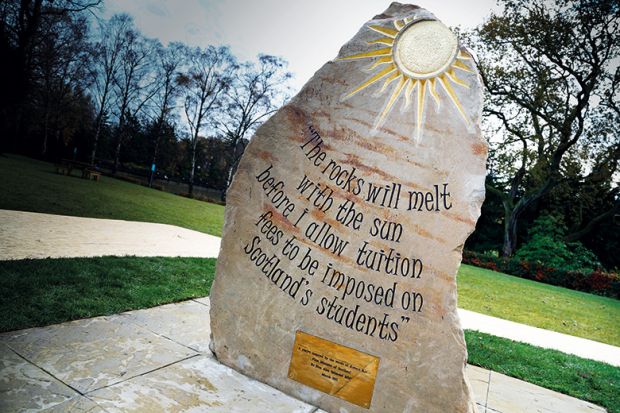Weighing nearly a tonne and carved from Clashach sandstone, one of Scotland’s more curious monuments can be found on the campus of Heriot-Watt University in Edinburgh.
The commemorative rock was installed in November 2014 as Alex Salmond prepared to stand down as the country’s first minister. It quotes the Scottish National Party politician’s position on higher education funding: “The rocks will melt with the sun before I allow tuition fees to be imposed on Scotland’s students.”
Free university study for home-domiciled students has become one of Scotland’s most distinctive policies since devolution was granted at the end of the 1990s. An independent review of tuition fees was promptly established by the Labour-Liberal Democrat coalition that formed the first Scottish Executive, as it was then known, and fees were replaced in 2001 by a graduate “endowment” of £2,289, which was paid by graduates when their earnings reached £15,000. The endowment, in turn, was abolished by the SNP when it came to power in 2007. Since then, Scottish students have saved more than £1 billion in fee payments compared with their peers south of the border, who now pay tuition fees of £9,000 a year.
But is this really a policy that should be celebrated and set in stone? Some observers worry about evidence suggesting that students from poorer backgrounds lose out under the current finance system, and that a difficult funding outlook puts the world-class reputation of the country’s universities at risk.
Concerns about higher education funding in Scotland were laid out most starkly in a report published earlier this year by the independent watchdog Audit Scotland. The document, Audit of Higher Education in Scottish Universities, found that it was getting harder for Scots to win a place at one of the country’s universities because the number of applications was increasing faster than the number of places, which is capped by the government to control the cost to the taxpayer. The proportion of applications by Scots that resulted in an offer fell from 57 per cent to 50 per cent between 2010 and 2015, while the proportion of applicants who did not receive any offers rose by four percentage points to 19 per cent over the same period.
Scottish universities receive £6,999 for each Scottish and European Union-domiciled student (EU law prevents students from other EU countries from being offered less favourable terms than domestic students, but it does not forbid universities from offering different terms to different groups of students within a member state). In its report, Audit Scotland says that this figure “does not reflect the actual cost” of teaching, resulting in Scottish universities becoming increasingly reliant on students from the rest of the UK and from outside the EU.
The offer rate for international students now stands at 63 per cent; for applicants from England, Wales and Northern Ireland, it is between 56 per cent and 58 per cent. These students are concentrated in the four “ancient” and most prestigious universities of St Andrews, Glasgow, Aberdeen and Edinburgh, with the consequence that Scottish students are now in the minority at these institutions.
The increasing difficulties that Scottish students have faced getting into university have contributed to the slow progress of efforts to widen access to higher education in the country. It is still the case that 18-year-olds from the most advantaged backgrounds are four times more likely than those from the least privileged areas to go straight to university, according to the Sutton Trust’s recent Access in Scotland report. In England, the equivalent figure is 2.4. The report also finds that increased competition for university places in Scotland has a disproportionately negative effect on students from poorer backgrounds because they are less likely to achieve the best school qualifications.
Scotland is also the only part of the UK in which students from poorer backgrounds end their degrees with larger debts than their more affluent peers, following the Scottish government’s 2013 decision to cut maintenance grants and offer loans instead. However, England’s decision to replace maintenance grants completely with loans from this year may move it closer to the Scottish position.
It could be argued that teaching standards in Scottish universities are suffering as a result of underfunding. An analysis by Times Higher Education of how Scottish institutions would fare if they participated in England’s forthcoming teaching excellence framework found that they generally underperform on the core metrics of student satisfaction, retention and graduate employment, with Edinburgh being the lowest-ranked member of the Russell Group of research-intensive universities.
There are also wider concerns about the financial sustainability of Scottish higher education, with the Audit Scotland report finding that surpluses were concentrated in just two universities: Edinburgh and Glasgow. The Scottish government currently spends about £300 million a year on tuition fees and student support, with fees representing the bulk of that, but some argue that this money could be better spent elsewhere. Capital funding is a particular priority, with public support having declined by 69 per cent in real terms between 2010-11 and 2014-15. In addition, institutions were able to cover only 84.8 per cent of the full costs of their research activity using research funding in 2014-15, according to Audit Scotland.
Universities Scotland, which represents the country’s 19 higher education institutions, responded to the Audit Scotland report by warning that the current success of the sector is “seriously threatened” by funding pressures, and research-intensive universities in particular have raised concerns about their ability to maintain their world-class reputation.
How sustainable, then, is free tuition in Scotland? And what are the prospects of significantly increased funding for Scotland’s higher education sector?
The Scottish government has stated that its key aim for the coming years will be reducing the attainment gap between rich and poor pupils at school level, and Sheila Riddell, director of Edinburgh’s Centre for Research in Education Inclusion and Diversity, says that it is “unlikely” that this could be achieved without the government prioritising that sector for funding.

“If more funds are to be channelled into schools, then I would say that that does beg some questions about whether free higher education is sustainable in the long run,” Riddell says. “I have no idea what [the Scottish government’s] way out of this conundrum is: it could be that, having talked very tough about doing something about inequality at school level, it proves impossible to do this without doing something about the relatively generous level of funding going into universities. That is possibly the most likely outcome; so if they want to put seriously more money into schools, they are really going to have to think about their priorities in a different way.”
But even if funding concerns lead the SNP to conclude that rethinking its free tuition policy would be wise, it is very difficult to see how such a U-turn could be performed. Going back on such a landmark pledge could have a catastrophic political cost – as could no doubt be confirmed by the Liberal Democrats, whose pledge before the 2010 general election not to increase tuition fees in England came back to haunt them at the following election after the party’s role in a coalition government that tripled fees. And there seems little prospect of any other Scottish party being able to push through university finance reform given the SNP’s iron grip on power – besides which, the Conservatives remain the only major party north of the border that backs the introduction of any form of graduate contribution.
Lucy Hunter Blackburn, formerly the Scottish government’s most senior civil servant on higher education and one of the authors of the Sutton Trust report, says that tuition fees are “dead as a debate” in Scotland. “I think there is a large body of opinion that’s actually more open-minded about means-tested fees or a moderate fee contribution, and the opinion polling is not devastating; but it has become so totemic for the SNP, I don’t think they would touch it,” she says.
Nor do universities seem to have any appetite to make the case publicly for tuition fees – even if, privately, many are critical of current policy, and, when the issue was last widely debated, in 2010, principals such as Glasgow’s Anton Muscatelli advocated the introduction of a graduate tax. Craig Mahoney, principal of the University of the West of Scotland, suggested last year in an interview with THE that sector leaders were wary of speaking out on the issue for fear of being punished by the SNP. In a “close-knit” country, “opposing government policy isn’t always welcomed”, he remarked.
Riddell agrees that universities are “being very quiet” on fees. “I think the ancient universities are probably quite concerned about what the government might do vis-à-vis widening access – they are not doing very well [on that] – so I think there isn’t an appetite to come to blows with the Scottish government on [the fees issue].”
It is also important to say that free tuition remains popular among voters, with only investing in the NHS being considered more important by respondents to a BBC poll conducted before the Scottish election earlier this year. And Vonnie Sandlan, president of the National Union of Students in Scotland, says that keeping tuition free is “absolutely the right thing to do”. “It demonstrates a commitment by our government to investing in the future: not only the future of the economy but [of] the actors within the economy,” she says. “When there is a lot being made of how the millennial generation is so much worse off than their parents, I think it is not so much about the political argument [as it is about the] moral and ethical argument. Having access to college and university protected in this way is a really strong and positive thing.” But she is also clear that the significant debts that the poorest students are now running up from maintenance loans must be “looked at urgently”.
Andrea Nolan, principal of Edinburgh Napier University and convener of Universities Scotland, rejects suggestions that institutions are unwilling to speak out on tuition fees but argues that whether tuition remains free or not is a “political decision”. “The government has made it quite clear on the basis of its manifesto that it will protect free tuition; so, within that context, what we argue for is sustainable funding,” she says.
“[The policy] is sustainable if the investment is put in behind it, but that is the choice. The government will have access to all the other calls on [public] funding in a way I and the college and university sector don’t have, and it depends on the choices you make,” Nolan says.
She warns that there are “huge challenges ahead” for higher education funding in Scotland, and that universities “can’t really hold on much longer” without a long-term settlement that commits to real-terms rises. But she is “optimistic that the government has committed to funding the universities so that they are…world-leading in their research and in their teaching. Until anything else happens, I am aligning my argument to the fact that I hope that the government sticks to that commitment.”
Whether Nolan’s optimism is well placed remains to be seen. Where, then, might there be other opportunities for Scottish universities to carve out a more sustainable funding position in the meantime?
Increasing the tuition fees charged to rest-of-UK students might be one option, with the TEF providing the means to do this. Fees for English institutions that meet expectations in the exercise will rise to £9,250 in 2017-18, and in line with inflation in subsequent years. However, more pessimistic observers suggest that increased fee income might simply provide an opportunity for the Holyrood government to claw back more money from the teaching grant.
The apprenticeship levy, which all large UK firms will have to pay from spring 2017, could provide another income stream for universities if they can persuade the government and employers that they should be permitted to deliver higher-level training using some of the money raised.
But perhaps the most significant opportunity could relate to future funding arrangements for EU students in the wake of the UK’s vote to leave the European Union. There were 14,300 EU undergraduates studying fee-free at Scottish universities in 2014-15 – 8.1 per cent of the total. Assuming that Scotland does leave the EU with the rest of the UK, it seems likely that students from the Continent would be charged the same fees as other international learners, allowing the freed-up government-funded places to be allocated to Scottish students instead. And even if, as seems likely, this resulted in a fall in EU recruitment, those EU students who did still come to Scotland could represent a significant new income stream, too.
“If the places taken by EU [students] become available to Scottish students, that would make really quite a big difference to the number of places available, and to the number of places available to students from less advantaged backgrounds,” observes Riddell.
Sandlan and Nolan also acknowledge the potential financial significance of ending free places for EU students. But both emphasise that such a move would have significant negative consequences, too, with Sandlan highlighting the positive contribution that EU students make.
“It’s not just in the classroom: it’s the impact on the local economy,” she says. “Our education institutions are richer for having that diversity of experience.”
All eyes, then, are on the Scottish government. Free tuition is a policy that looks likely to remain set in stone, but, depending on the decisions the politicians take, other aspects of Scottish higher education, such as widening access, research and international reputation, could increasingly suffer as a result. In such circumstances, some may increasingly come to regard Heriot-Watt’s slab of Clashach sandstone as something of a millstone around universities’ necks.
POSTSCRIPT:
Print headline: Stone of destiny?
Register to continue
Why register?
- Registration is free and only takes a moment
- Once registered, you can read 3 articles a month
- Sign up for our newsletter
Subscribe
Or subscribe for unlimited access to:
- Unlimited access to news, views, insights & reviews
- Digital editions
- Digital access to THE’s university and college rankings analysis
Already registered or a current subscriber? Login








